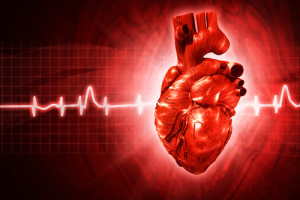The heart is the key to life as we know it. If it fails we die. Cardiovascular exercise is a life affirming activity because it is focused on the heart. The idea of cardiovascular training is to stress the heart and cardiovascular system so that we bring oxygen and nutrients to all the tissues of the body and strengthen the heart muscle itself. The process whereby the arteries that transport the oxygenated blood from the heart to the muscles also give us the ability to accomplish the normal activities of daily life.
 A cardio training session is characterized by continuous movement over time at a specified rate of speed. Walking for an extended period of time would qualify as a form of cardio exercise. Playing tennis does not qualify as a cardio activity because it does not consist in continuous movement, just as a round of golf doesn’t. Other types of cardio exercise are cycling, swimming laps, hiking, running, cross country skiing and other such activities that require one to work overtime and involve a constant effort to maintain muscular involvement of all the major muscle groups on the body.
A cardio training session is characterized by continuous movement over time at a specified rate of speed. Walking for an extended period of time would qualify as a form of cardio exercise. Playing tennis does not qualify as a cardio activity because it does not consist in continuous movement, just as a round of golf doesn’t. Other types of cardio exercise are cycling, swimming laps, hiking, running, cross country skiing and other such activities that require one to work overtime and involve a constant effort to maintain muscular involvement of all the major muscle groups on the body.
Understanding Heart Rates
1. RESTING HEART RATE: This is measured in the morning before you get out of bed. It is done by placing two fingers on the wrist (radial artery) or neck (carotid artery) for 60 seconds and counting the number of beats. This number can also be found by counting for 15 seconds and multiplying by four. Your resting heart rate is used in calculating training heart rates and will be an indicator of improvement resulting from cardio training. My resting heart rate has been as low as 40 beats per minute (the average is 72 bpm).
2. TARGET HEART RATE: The idea of establishing a target heart rate is to “find your starting place” and determining the intensity during your training session. Each bout of cardio can be anywhere from 20 minutes to an hour or more – depending upon your fitness goals and preparedness. The more conditioned one is, the more “work” one can do in a shorter period of time – burning more calories as a result – and strengthening the heart as well. To determine your target hear rate, take 220 minus your age and that will give you a rough “maximum heart rate”. Multiply that result by 50-85% to establish the range for your heart rate. In my case, I’ll be 70 in August, so:
220 – 70 = 150 (maximum hear rate)
150 x .5 = 75 beats per minute (low end)
150 x .85 = 127 beats per minute (upper limit)
Knowing these two parameters is important – for both success – and safety. The less conditioned you are, the lower the intensity you should start from. The more conditioned you are, the more intensity you can bring to your chosen activity. Intensity is determined during and after the activity by counting the number of beats in a 6 second count and multiplied by ten.
If you have questions do seek the assistance of a fitness professional in guiding you to your own individualized program. Do consult a medical professional before beginning ANY exercise program requiring an understating of your current fitness levels while discovering any personal limitations that may have such as joint issues, heart issues, blood pressure issues, medications and other potential “red flags”.
The Benefits of Cardiovascular Training
Being aware of the many benefits of cardio training and reminding yourself about them is crucial to ensuring that you remain committed to your fitness and health goals.
The amount of blood pumped by the heart in one contraction is called stroke volume (SV). Stroke volume improves as a consequence of cardio training resulting in decreased blood sugar levels, improved lipid profile (circulating fat called triglycerides), improved stress responses, a calming of the mind, and increased energy levels to mention just a few. Here’s a more detailed list of the benefits of cardio training:
Improved respiratory function:
- Increased maximal ventilation – deeper breaths.
- Increased lung diffusion capacity – more oxygen available through each breath.
Improved heart function:
- Lowered blood pressure.
- Decreased resting heart rate.
- Increased heart volume – more oxygenated blood available for work.
- Increased resting and maximum stroke volume.
- Increased maximum cardiac output.
- Increased capillary density and blood flow to the active muscles and tissues.
- Increased total blood volume.
Increased fitness level:
- Increased aerobic (exercise with oxygen) work capacity.
- Increased lactate threshold (higher intensity capability).
- Increased maximum oxygen consumption – meaning longer exercise times.
Improved metabolism:
- Increased HDL cholesterol – (“good”) cholesterol that helps “strip” away LDL (“bad”) cholesterol.
- Decreased total cholesterol.
- Increased mobilization and utilization of stored fat.
- Decreased body fat storage.
- Reduction in glucose (sugar) – stimulated insulin secretion.
 Increased overall wellness:
Increased overall wellness:
- Reduction of all causes of mortality.
- Decreased incidence of some cancers.
- Reduction in mortality in post myocardial infarction (heart attack) patients.
- Decreased clinical symptoms of anxiety, tension and depression: the “runner’s high”, as an example, it is real!
The many gifts of cardio training are known but the key to this process is the body’s increased ability to burn calories. Weight management, maintenance – and indeed weight loss – is a known benefit of cardio exercise. If we train our bodies to anticipate a period of heightened calorie burning each day we will establish the greatest result of all: a higher resting metabolic rate that supports all levels of health for us.
These benefits are valid reasons for embracing cardio training on higher and more challenging levels and should motivate you to incorporate some form of this training into your daily life.
Exercise tips and cautions
- Be flexible and adaptable in your thinking when planning your exercise program.
- Allow for recovery days.
- Cross train. Include a variety of exercises that can complement your primary activity. In my case, cycling complements running and weight training supports my cardiovascular activity. I train with weights to keep running. Make sure you do both cardio and weight training.
- Consider doing interval training, or other forms of high intensity training, as in spite of being challenging, they are incredibly satisfying.
- HAVE FUN! Find which form of exercise would make you happy and then go for it. This might involve trying different things out. If the activity you chose is not fun – you won’t continue doing it.
- Decide on a schedule and stick to it. Be mentally tough and don’t give in to the temptation to quit. Remember: “Winners never quite and quitters never win!”
- Make preparations for all activity by stretching and mentally preparing for your challenge.
- Check whether you re working at the right intensity. The “talk test” will tell you. For example, if you decide to walk on a treadmill to warm up, then have someone talk with you and see if you can respond. If you can, you are working at the right intensity.
- Learn your basic heart rates – they will serve you well.
- Keep monitoring your heart rates. As you get to a more highly conditioned state, you will be able to perform at varying intensities and get closer to your fitness ideal.
- List any personal or environmental information that reduces the risk of injury or that may compromise exercise safety.
- Do not exercise for at least 90 minutes after a meal.
- Avoid continuing exercise with chest discomfort, light headedness or dizziness.
- Reduce exercise intensity in response to very hot or humid environments or to high altitude training.
- Avoid exercise with tenderness in a joint (ex. In a knee or foot) that tends to worsen with activity.
- Avoid continuous aerobic exercise during viral infections such as the flu or upper respiratory tract infections.
My experience…
I started running to relieve the stress of homesickness during my freshman year at Syracuse University and fortunately for me it developed into a lifestyle that I carried into the next decades of my life. When I think of the years I have been a runner, I am so grateful I found something so healthy for my body, mind, spirit – and heart. I am convinced that running saved my life.
Due to injury to my feet these past few months (inflammation and pain), I reduced the running and started riding a stationary bike to allow my injuries to heal. It took time, but it has worked and I am running pain free now (with the help of new shoes and inserts). I am now incorporating cycling sessions into my training routine to minimize the risk of additional plantar fascia injury. This is what I mean by being flexible and listening to your body.
I love running fast and will for as long as I can. It is the way I love to run as I enter my 70’s. Jogging was never for me so I “play” with each program I do and challenge myself daily to improve – or reach for higher goals. It energizes me – and it will do the same for you as well.
Originally posted on healthynewage.com. Reprinted with permission from Nicholas Prukop.
Nicholas Prukop is an ACE Certified Personal Trainer & a Health Coach, a fitness professional with over 25 years of experience whose passion for health and fitness comes from his boyhood in Hawaii where he grew up a swimmer on Maui. He found his calling in writing his first book “Healthy Aging & You: Your Journey to Becoming Happy, Healthy & Fit” and since then he has dedicated himself to empowering, inspiring and enabling people of all ages to reach for the best that is within them and become who they are meant to be – happy, healthy and fit – and be a part of a world where each person can contribute their own unique gifts to life.

